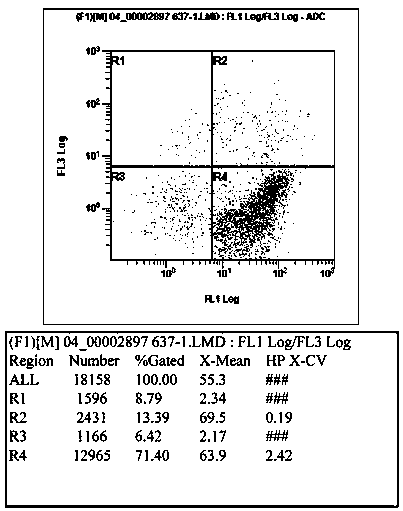Bivalve mollusc semen quality detection method
A technology for sperm quality and bivalve molluscs, applied in measuring devices, individual particle analysis, scientific instruments, etc., can solve the problems of plasma membrane integrity and mitochondrial activity, the inability to detect changes in sperm structure, and the impact of sperm quality, etc. problems, to avoid low accuracy, ensure accuracy, and improve accuracy
- Summary
- Abstract
- Description
- Claims
- Application Information
AI Technical Summary
Problems solved by technology
Method used
Image
Examples
Embodiment 1
[0023] A bivalve mollusk quality detection method and its application, the specific operation steps are as follows:
[0024] 1. Semen preparation: select well-developed oysters, select male individuals with well-developed gonads through anatomical microscopy, and use a straw to absorb sperm with better vitality as the sperm stock solution.
[0025] 2. Gradient seawater configuration: Use sterilized seawater, sea crystals and aerated freshwater to prepare gradient seawater with a salinity of 10, 15, 20, 25, 30, and 35, add the sperm stock solution to the gradient seawater, and adjust the sperm concentration to 10 7 ~10 8 individual / mL.
[0026] 3. Preparation of fluorescent dye solution: Dissolve PI and Rh123 in ultrapure water respectively to make a storage solution with a concentration of 1mg / mL, and store them at -20°C and -4°C respectively according to the reagent storage requirements.
[0027] 4. Semen staining: Dilute the two storage solutions to 100 μg / mL, take 160 μL...
Embodiment 2
[0032] A bivalve mollusk quality detection method and its application, the specific operation steps are as follows:
[0033] 1. Semen preparation: Anatomical microscopy, select the male oysters with well-developed glands, use a straw to absorb the sperm with better vitality as the sperm stock solution.
[0034] 2. Environmental temperature setting: Use heating rods, ice cubes, and refrigerators to set the temperature in the water bath environment at -20°C, 4°C, 14°C, 24°C, 34°C, 44°C, and 54°C, and adjust the sperm concentration to 10°C. 7 ~10 8 individual / mL, and then put the sperm into water baths at different temperatures.
[0035] 3. Preparation of fluorescent dye solution: Dissolve PI and Rh123 in ultrapure water respectively to make a storage solution with a concentration of 1mg / mL, and store them at -20°C and -4°C respectively according to the reagent storage requirements.
[0036]4. Sperm staining: Dilute the two storage solutions to 100 μg / mL, take 240 μL of sperm a...
Embodiment 3
[0040] A bivalve mollusk quality detection method and its application, the specific operation steps are as follows:
[0041] 1. Semen preparation: Microscopically examine the male scallops with well-developed selective glands, and use a straw to absorb the sperm with better vitality as the sperm stock solution.
[0042] 2. Gradient seawater configuration: Use sterilized seawater, sea crystals and aerated freshwater to prepare gradient seawater with a salinity of 5, 10, 15, 20, 25, 30, 35, and 40, and add the sperm stock solution to the gradient seawater. Adjust sperm concentration to 10 7 ~10 8 individual / mL.
[0043] 3. Preparation of fluorescent dye solution: Dissolve PI and Rh123 in ultrapure water respectively to make a storage solution with a concentration of 1mg / mL, and store them at -20°C and -4°C respectively according to the reagent storage requirements.
[0044] 4. Sperm staining: dilute the two storage solutions to 100 μg / mL, take 160 μL of the spermatozoa subjec...
PUM
 Login to View More
Login to View More Abstract
Description
Claims
Application Information
 Login to View More
Login to View More - R&D
- Intellectual Property
- Life Sciences
- Materials
- Tech Scout
- Unparalleled Data Quality
- Higher Quality Content
- 60% Fewer Hallucinations
Browse by: Latest US Patents, China's latest patents, Technical Efficacy Thesaurus, Application Domain, Technology Topic, Popular Technical Reports.
© 2025 PatSnap. All rights reserved.Legal|Privacy policy|Modern Slavery Act Transparency Statement|Sitemap|About US| Contact US: help@patsnap.com

